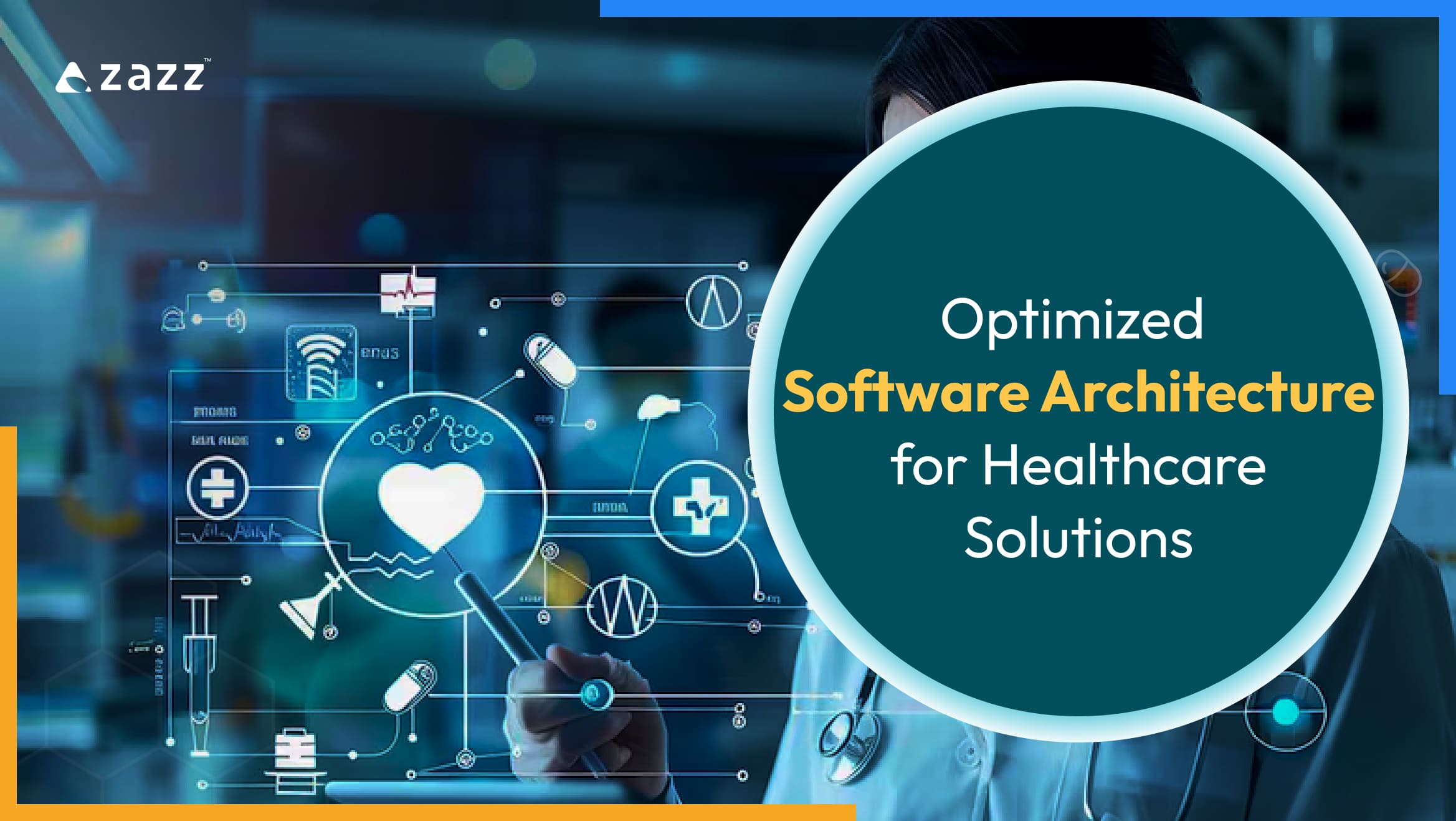
In today’s rapidly evolving healthcare landscape, the importance of a well-structured software architecture cannot be overstated. As healthcare systems increasingly adopt digital tools to enhance patient care, streamline workflows, and comply with stringent regulations, the underlying software architecture must be resilient, scalable, and secure—especially as healthcare data faces growing cybersecurity threats.
For instance, in October 2022, one of the largest hospital chains in the U.S. experienced a major cybersecurity breach that led to ambulance diversions and emergency measures to protect critical systems. This incident underscores the pressing need for robust healthcare software architecture to prevent vulnerabilities and ensure continuous operations.
As healthcare pivots toward automation, it aims to improve speed, accuracy, and usability. Software now plays an essential role in areas like electronic health records (EHRs), telemedicine, diagnostics, and patient monitoring tools, offering professionals the ability to provide enhanced care and empowering patients with self-management tools.
This blog explores key aspects of healthcare software architecture, focusing on best practices, challenges, and strategies for building efficient, adaptable systems that meet the ever-evolving demands of the industry.
Related reading: Top 5 Healthcare Mobile App Features in 2024
Challenges & Solutions In Healthcare Software Development
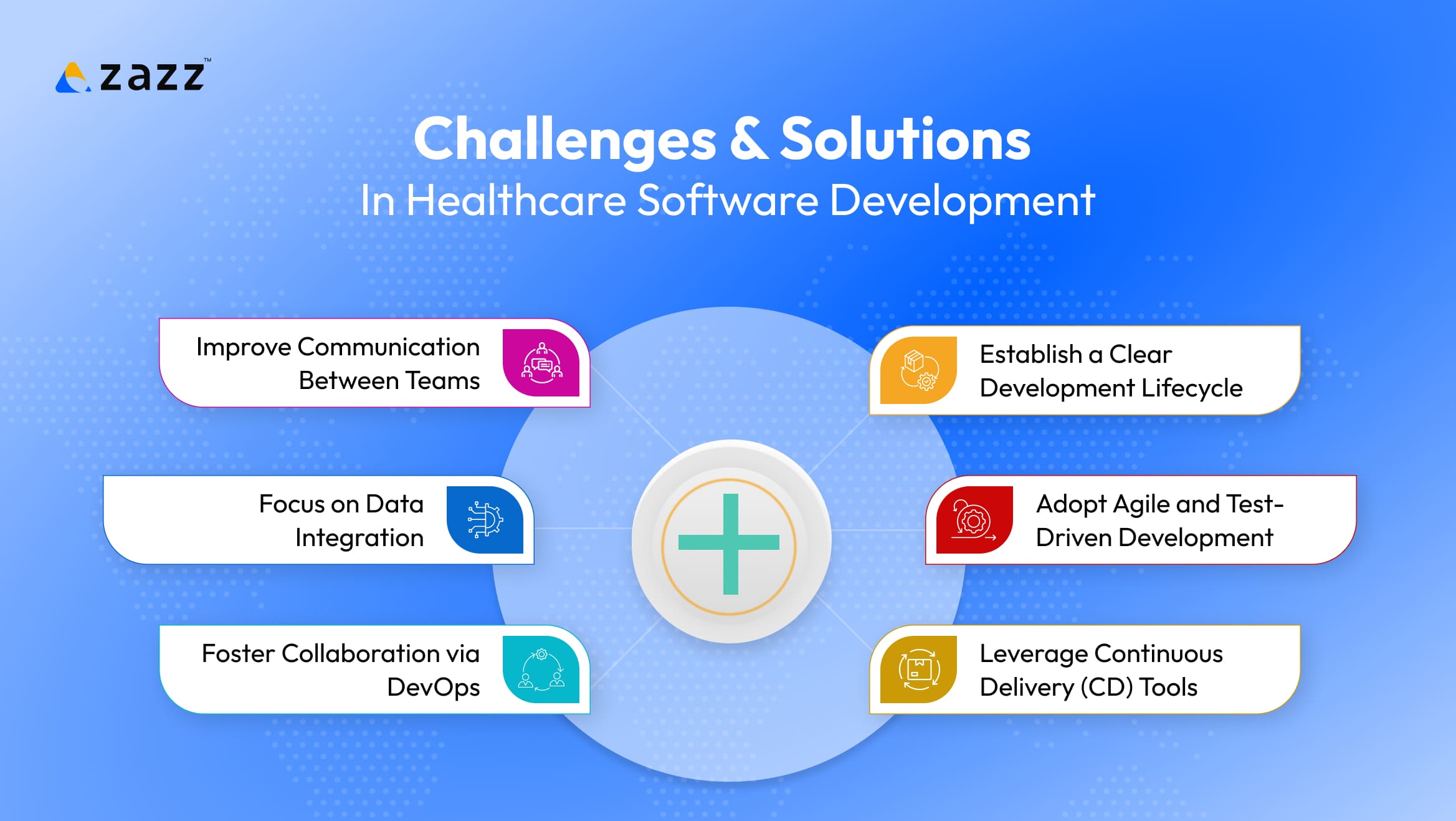
Healthcare software development is accompanied by unique challenges that require a thoughtful and strategic approach. Some of these hurdles include balancing regulatory compliance with innovation, fostering collaboration across multiple stakeholders, and ensuring effective communication between development teams and clinical staff. Security and privacy concerns, coupled with the rapidly changing technological landscape, add further complexity.
To address these challenges, healthcare organizations must adopt multifaceted strategies:
Establish a Clear Development Lifecycle
Define a robust software development lifecycle (SDLC) that includes setting comprehensive requirements and adhering to secure coding standards. This ensures the software is secure, compliant, and of high quality from the outset.
Adopt Agile and Test-Driven Development (TDD)
Utilizing Agile methodologies and TDD helps teams respond quickly to changing requirements while maintaining the quality, security, and regulatory compliance needed in healthcare.
Leverage Continuous Delivery (CD) Tools
CD tools allow teams to deploy software safely and swiftly, ensuring timely updates without compromising on quality.
Foster Collaboration via DevOps
Collaboration between developers, IT, and clinicians is critical. DevOps practices enhance this communication, aligning all teams toward shared goals of delivering secure, reliable solutions.
Focus on Data Integration
Seamless integration of data from multiple sources provides critical insights into patient care and enables more informed decision-making.
Improve Communication Between Teams
Effective collaboration between clinical and technical teams ensures software meets clinical needs while staying compliant with healthcare regulations.
Related reading: Top 10 Benefits Of Mobile Apps In Healthcare Industry
Containerization in Healthcare Software Development
Containerization has become a leading solution in the healthcare industry, significantly transforming healthcare software from development to management. This innovative approach enables developers to package software along with all necessary tools and configurations into “containers.” As a result, healthcare software can run consistently across various systems, ensuring reliable performance—an essential factor in an industry where reliability is critical.
Let’s look at some of the key benefits of Containerization:
- Consistency: Containers ensure that software performs consistently across development, testing, and production stages. This uniformity reduces the risk of severe consequences, particularly in the fragile healthcare environment where reliability is crucial.
- Scalability and Flexibility: With tools like Docker and Kubernetes, healthcare providers can effortlessly scale their applications to accommodate more users or processes. This capability helps control costs and meet demand during peak times, especially in health crises.
- Easier Updates and Deployment: Containerization streamlines the software updating process. Healthcare organizations can introduce new features or implement changes without disrupting patient care or other services, which is especially beneficial given the frequent need for software updates to comply with regulatory changes.
- Improved Security: Containers isolate applications from one another, minimizing the risk of security threats spreading across systems. When paired with tools like Kubernetes, organizations can enhance security through network controls and automatic threat detection, safeguarding sensitive patient data.
- Better Integration: In healthcare, it’s often essential for different software systems to work together. Containerization facilitates a “microservices” architecture, allowing various system components to be built, updated, and managed independently. This modularity simplifies the integration of new technologies.
By using containerization, healthcare organizations can stay ahead of the curve while ensuring their systems are scalable, reliable, and secure—three must-haves in the healthcare industry.
Related reading: Building Custom Medical Billing Software: A Complete Guide
Quality Assurance in Healthcare Software
Quality assurance (QA) plays a crucial role in ensuring that healthcare software functions effectively, is secure, and meets regulatory standards. Given the critical nature of healthcare application development, rigorous QA processes are non-negotiable.
Healthcare organizations should implement both manual and automated testing methodologies. Automated testing services is particularly valuable for increasing efficiency by detecting bugs early and reducing repetitive tasks, freeing QA teams to focus on more complex aspects like usability and security assessments.
Understanding regulatory requirements is another cornerstone of successful QA. The FDA, for instance, offers guidance on agile methodologies and regulations governing software related to medical devices. These regulations ensure that software products not only meet industry standards but also prioritize patient safety.
Key QA Methodologies Include:
- Unit Testing: Focuses on individual software components to ensure they function correctly in isolation.
- Integration Testing: Ensures different components of the software work together seamlessly, a critical factor for interoperability in healthcare.
- Regression Testing: Ensures that software modifications don’t disrupt existing functionality.
- User Acceptance Testing (UAT): Allows real-world users—such as clinicians and administrative staff—to test the software, ensuring it meets practical needs before deployment.
Related reading: What Is Interoperability in Healthcare? Complete Guide
Key Factors that Impact Healthcare Software Architecture
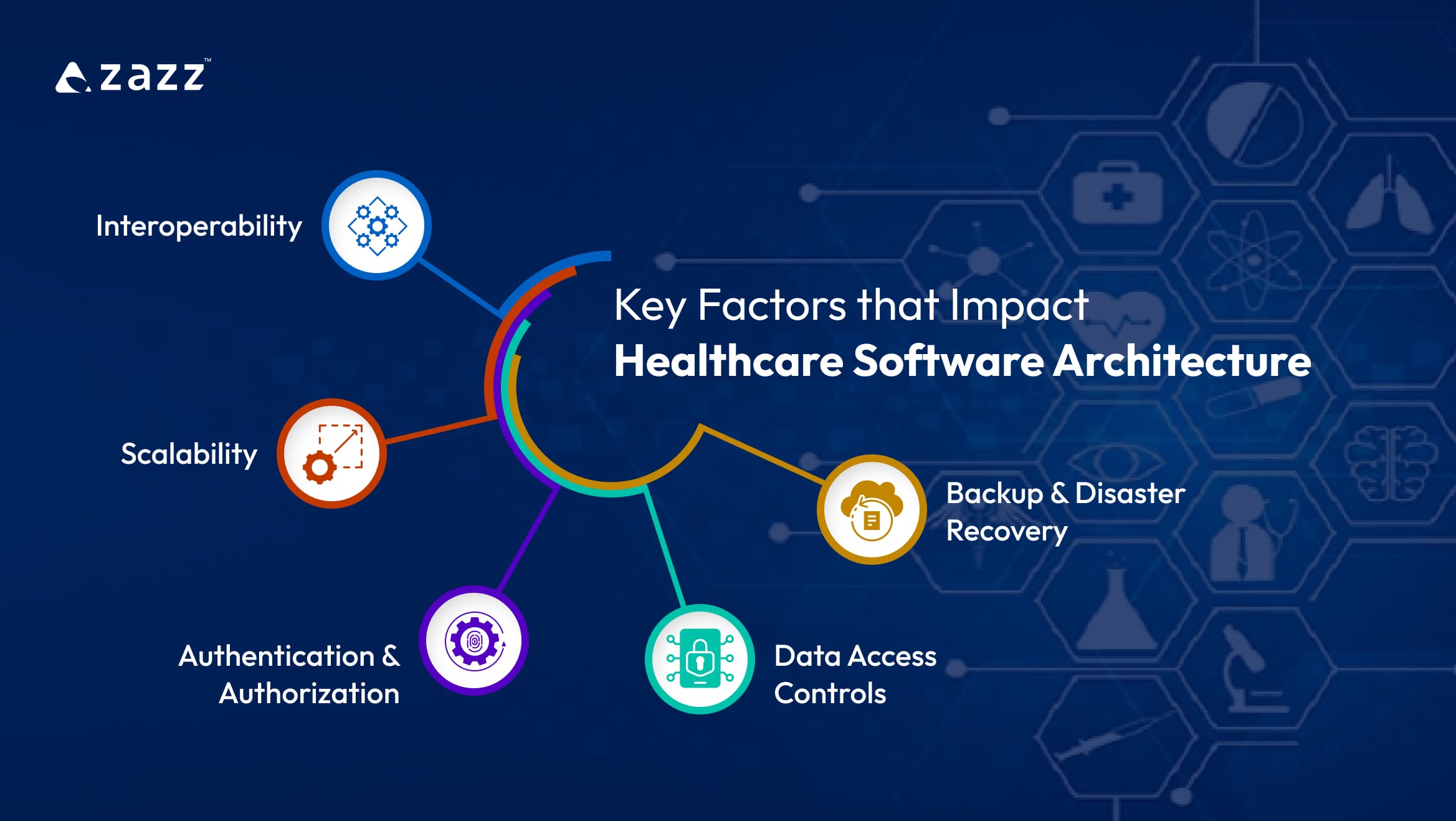
The architecture of a healthcare application is an essential component of the software development process, tailored to the healthcare environment’s unique requirements and the application’s specific objectives.
When crafting the architecture of a healthcare application, ask yourself these questions.
What’s your healthcare goal?
- The goal, otherwise known as Domain scoping, ensures healthcare apps align with strategic goals from a high-level perspective, focusing on healthcare architecture and essential features like patient management, appointment scheduling, diagnostics to support core system operations, telemedicine, managing electronic health records (EHR), or medical imaging.
- Domain scoping defines the software scope by ensuring all technical aspects meet business objectives and healthcare-specific needs, including compliance and data management. It examines user needs, stakeholders, and operational constraints while prioritizing critical features like data security, privacy, and scalability in a healthcare environment.
- In short, domain scoping involves analyzing a product from a bird’s-eye view to ensure your software effectively meets your healthcare needs.
Is it scalable?
- You deal with a lot of patient data, and your software must scale as the data grows.
- Opt for an architecture that allows horizontal scaling, so you can add more resources without sacrificing performance.
How to make it real-world environment friendly?
- When developing healthcare architecture, you need to craft the design to align with healthcare-specific data flows, regulations, and system interactions, ensuring compliance and efficiency in operation- otherwise known as Domain Modeling.
- You should define healthcare entities, such as patients, doctors, and medical records, along with their relationships to accurately represent how they interact within the system.
- Create abstract models to illustrate data flow, user interactions, and system behaviors, and identify architectural patterns, like microservices or event-driven architecture, that best suit your app.
- In short, Domain modeling serves as a blueprint for your healthcare architecture, outlining how different components and entities interact within the system.
How about Interoperability?
- Your software needs to integrate easily with other healthcare systems like EHR, LIS (Laboratory Information Systems), and PACS (Picture Archiving and Communication Systems).
- Look for an architecture with well-defined APIs and standard protocols to ensure smooth communication.
How strong are its security and compliance features?
- Protecting patient data is critical, and your software must comply with regulations like HIPAA and GDPR.
- Ensure proper data encryption, access controls, and audit trails are in place to safeguard sensitive information.
How flexible can Microservices Modularity Be?
- As your software grows, it should be able to handle more users and features.
- Use a microservices architecture to break down complex functionalities into smaller, manageable services.
- This makes it easier to add new features, maintain the system, and scale specific parts as needed.
How does its user-centric interface improve user experience?
- Your software should prioritize user experience, whether it’s for clinicians, admin staff, or patients.
- Make sure it has an intuitive interface and supports efficient workflows to make it easy for people to use.
How can performance optimization enhance speed and efficiency?
- Your software must be fast and responsive, especially in critical healthcare situations.
- Use caching, load balancing, and content delivery networks to keep performance smooth and reduce delays.
How flexible is your software in terms of deployment options?
- Your software should be flexible in how it’s deployed (on-premise, cloud, or hybrid) to meet your organization’s needs.
- Make deployment choices based on cost, security, and technical requirements.
How do you select a technology stack suitable for the healthcare industry?
- Select a technology stack that adheres to healthcare best practices and keeps up with industry trends.
- Make sure the programming languages, frameworks, and tools fit your software development needs.
How pocket friendly can it be?
- Keep your budget in mind when choosing an architecture.
- Different architectures come with different costs, so ensure your choice matches your financial development resources.
Should you be consulting with industry experts?
- Just like architects consult engineers, you should seek advice from healthcare software experts.
- Work with professionals who understand healthcare systems to avoid pitfalls and follow best practices.
These design considerations must be carefully assessed to build a healthcare application that is secure, reliable, and high-performing. As ransomware attacks become more frequent, is your organization prepared to tackle these threats? Contact Zazz to guide you in giving your app a makeover or starting from square one with you, not for you. We’re here to support you every step of the way.
Related reading: Developing a Healthcare App in 2024 – A Complete Guide
Deploying Healthcare Software: From Development to Production
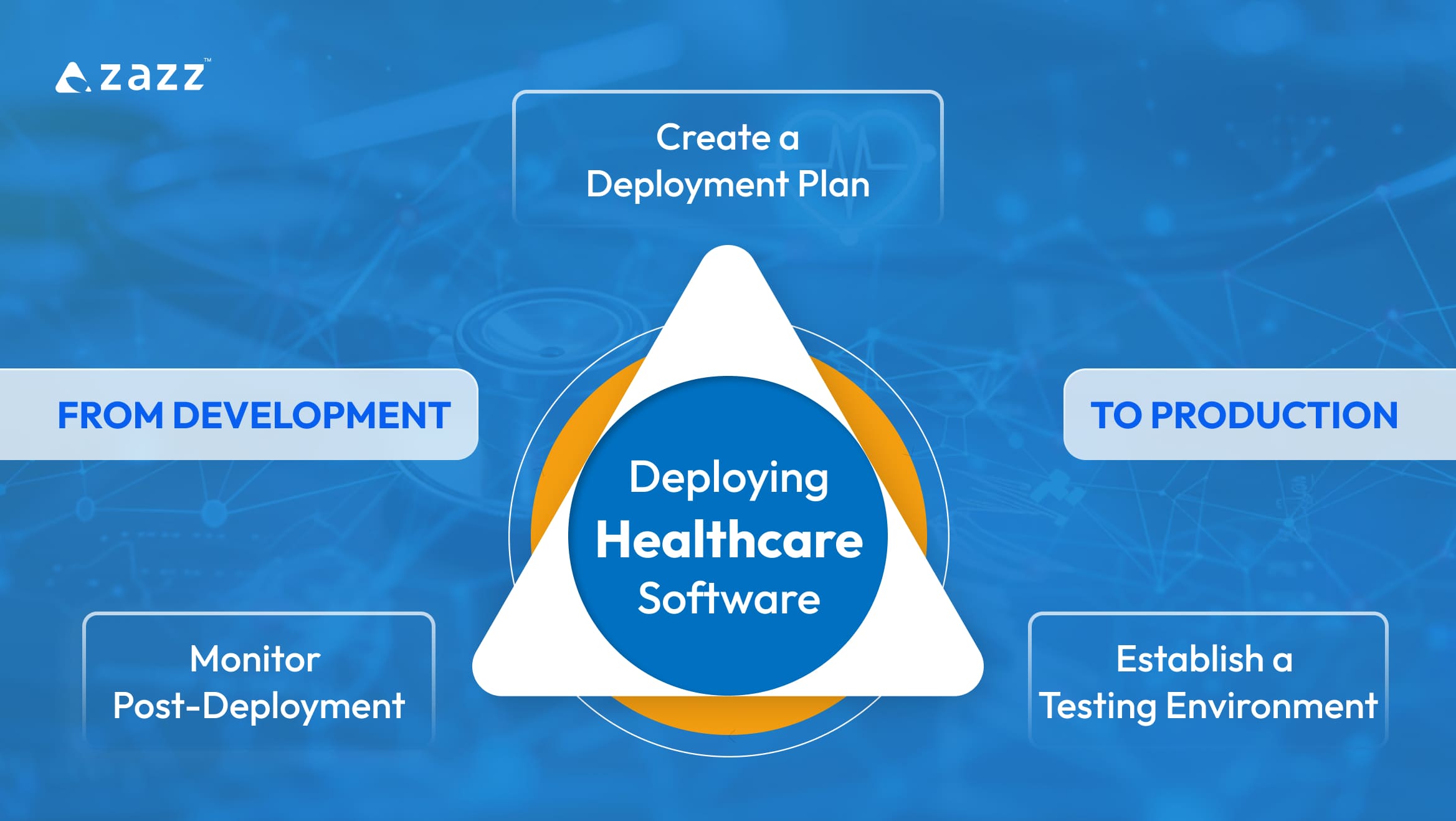
Once a healthcare application has been developed, deploying it to a production environment presents its own set of challenges, especially given the complex and diverse nature of healthcare settings.
A successful deployment requires a well-structured plan that outlines how the application will interact with the target environment. Here are the key steps involved in this process:
Create a Deployment Plan
Begin by crafting a comprehensive deployment plan that details the interaction between the application and the production environment. This plan should include timelines, resource allocation, and potential risks associated with the deployment.
Establish a Testing Environment
Before moving to production, it’s crucial to set up a testing environment that closely mirrors the production environment. This simulation ensures that the deployed code adheres to the rigorous standards expected in healthcare settings.
Monitor Post-Deployment
After deployment, continuous monitoring of the software is essential. This vigilance helps verify that the application functions as intended and allows for the swift identification and resolution of any issues that may arise.
Related reading: An Exhaustive Guidebook for Developing a Telemedicine App
Prioritizing Patient Safety and Enhancing their Experience
Patient safety is paramount for healthcare organizations. To ensure the best possible care, it’s essential to have systems that can proactively identify and prevent errors.
Healthcare software can significantly contribute to patient safety by providing timely alerts and reminders to clinicians. Additionally, data analytics can help identify trends and potential issues before they escalate.
Enhancing the patient experience is equally important. Healthcare software can empower patients by giving them access to their health data, simplifying the appointment scheduling process, and facilitating prescription refills. Automated messaging can keep patients updated on their care status, ensuring they remain informed.
Patient portals should be designed to offer a secure and convenient platform for communicating with healthcare providers and accessing educational materials. This helps patients understand their health conditions better and promotes greater engagement and satisfaction.
Furthermore, healthcare systems can leverage patient feedback to tailor their services to better meet the needs of their patient population. Investing in staff training on the use of healthcare software is crucial. Well-trained staff can optimize the use of these tools, leading to improved patient experiences and outcomes.
Related reading: How Custom Software Development is Changing the Healthcare Industry
Zazz’s IT Portfolio Covering Healthcare Solutions
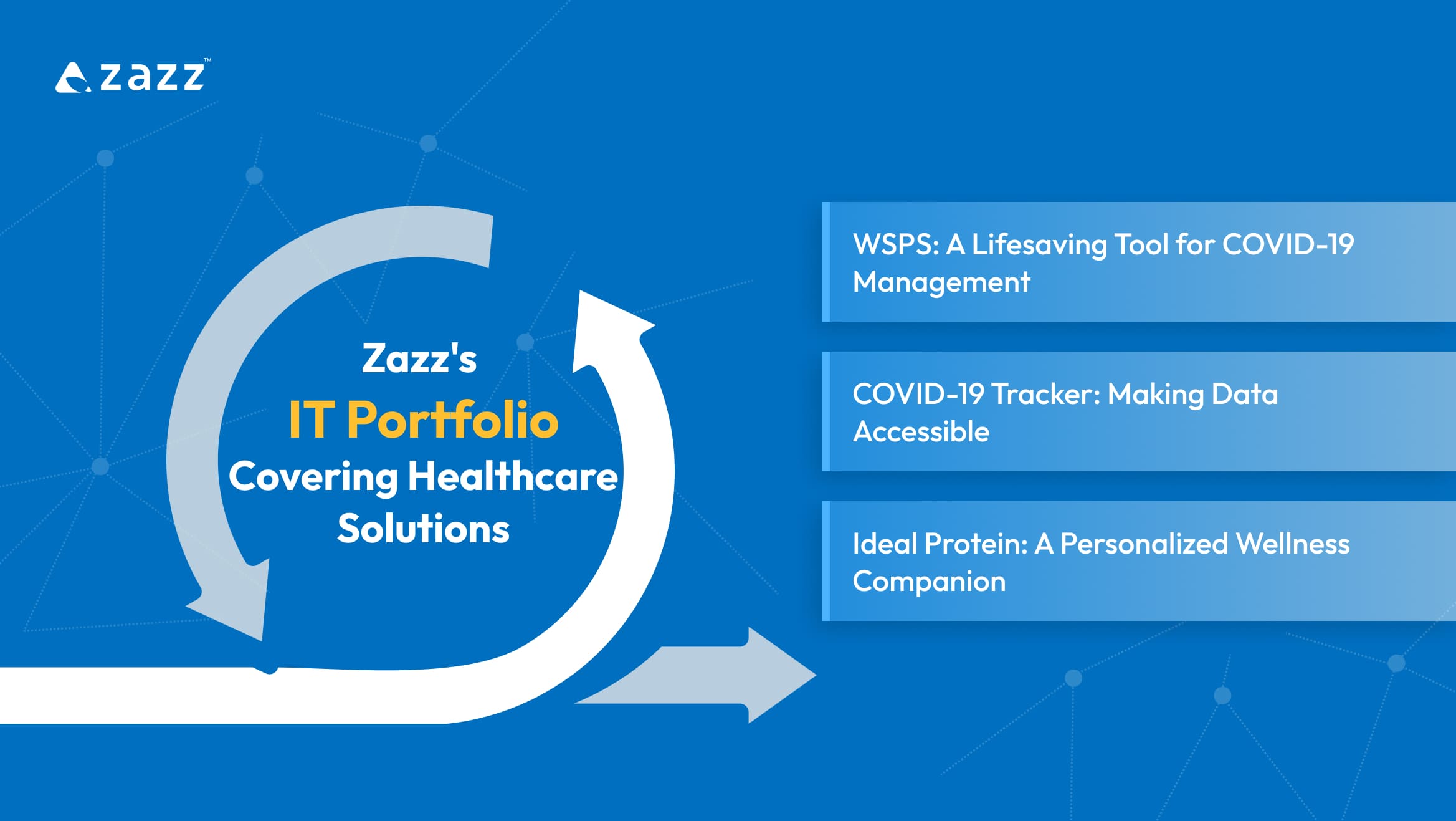
Zazz has made significant strides in the healthcare sector by developing innovative software solutions tailored to address pressing challenges. Here are three standout web development case studies that highlight Zazz’s impact:
WSPS: A Lifesaving Tool for COVID-19 Management
Zazz developed the Workplace Safety and Prevention Services (WSPS) platform to provide essential resources for Canadian employers during the COVID-19 pandemic. This application delivers reliable, up-to-date information to help organizations make informed decisions and take proactive measures to safeguard employee health. By aggregating critical data, WSPS has played a pivotal role in preventing the spread of the virus and protecting workplaces across Canada, showcasing how tailored software can save lives in times of crisis.
COVID-19 Tracker: Making Data Accessible
The COVID-19 Tracker is an independent initiative designed to aggregate, visualize, and share COVID-19 data for both Canada and the United States. Zazz’s development team created an intuitive dashboard and data API, allowing users to access real-time, granular data. This transparency empowers individuals and organizations to stay informed about the pandemic’s status, enabling them to make educated choices about their health and safety. By democratizing access to critical health data, Zazz has helped foster a more informed public during unprecedented times.
Ideal Protein: A Personalized Wellness Companion
The Ideal Protein app acts as a digital pocket companion for users following the Ideal Protein protocol. Zazz designed this app to guide individuals through their weight loss journey, supporting them in achieving their health goals. The app features a personalized assistant that helps users navigate three proprietary phases: weight loss, stabilization, and maintenance. By integrating technology into personal health journeys, Zazz demonstrates the potential for software development to enhance individual well-being and promote healthier lifestyles.
Through these case studies, Zazz exemplifies its commitment to improving healthcare outcomes by developing innovative software solutions that address critical industry needs. Our work not only enhances patient care but also streamlines healthcare processes, demonstrating the transformative power of technology in the sector.
Related reading: How can AI help reduce readmissions?
Conclusion
In conclusion, a well-structured healthcare software architecture is vital for optimizing digital solutions that enhance patient care, streamline operations, and ensure regulatory compliance. Healthcare organizations can create resilient, scalable, and secure applications that drive positive outcomes by adopting best practices, addressing challenges, and leveraging innovative strategies.
As healthcare continues to embrace digital transformation, the importance of robust software architecture cannot be overstated. Organizations can position themselves at the forefront of healthcare innovation by prioritizing patient safety, enhancing the patient experience, and investing in the right technologies.
If your organization is looking to improve its healthcare software architecture, consider partnering with experienced software development teams like Zazz to ensure the best possible outcomes for your patients and your practice.
Frequently Asked Questions
Software architecture in healthcare apps refers to the structured design and organization of the software components that make up the application. It defines how the app operates, scales, and integrates with other systems. At Zazz, we ensure that our healthcare app architecture is secure, scalable, and optimized for the complex needs of the healthcare industry.
A well-designed software architecture is crucial for healthcare apps because it ensures the app’s performance, data security, and compliance with healthcare regulations like HIPAA. At Zazz, we build architectures that allow seamless patient data management, enhanced security, and smooth integration with healthcare systems.
Zazz integrates robust security protocols such as encryption, multi-factor authentication, and compliance with HIPAA and GDPR standards. We build secure data flows within the app architecture to protect sensitive healthcare information from breaches and unauthorized access.
Zazz’s architecture supports various healthcare apps including telemedicine platforms, electronic health records (EHR) systems, patient portals, and healthcare management tools. Our flexible architecture ensures scalability and adaptability for diverse healthcare solutions.
Zazz designs healthcare app architecture to scale efficiently as your user base grows. We implement microservices and cloud-based solutions that allow apps to expand their functionalities, handle increasing data loads, and support a growing number of users without compromising performance.
Zazz prioritizes user experience by designing intuitive, responsive, and fast-loading healthcare apps. We employ performance optimization techniques in our architecture to ensure that users can access services smoothly, even during high traffic periods.
Recent Articles
Table of Content 1. What is IT Staff Augmentation? 2....
Table of Content 1. What is Staff Augmentation for App...
Table of Content 1. What is IT Staff Augmentation? 2....












